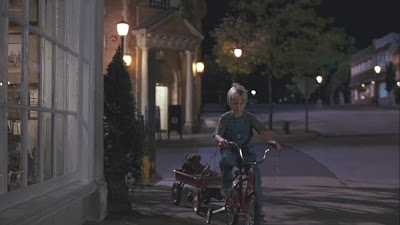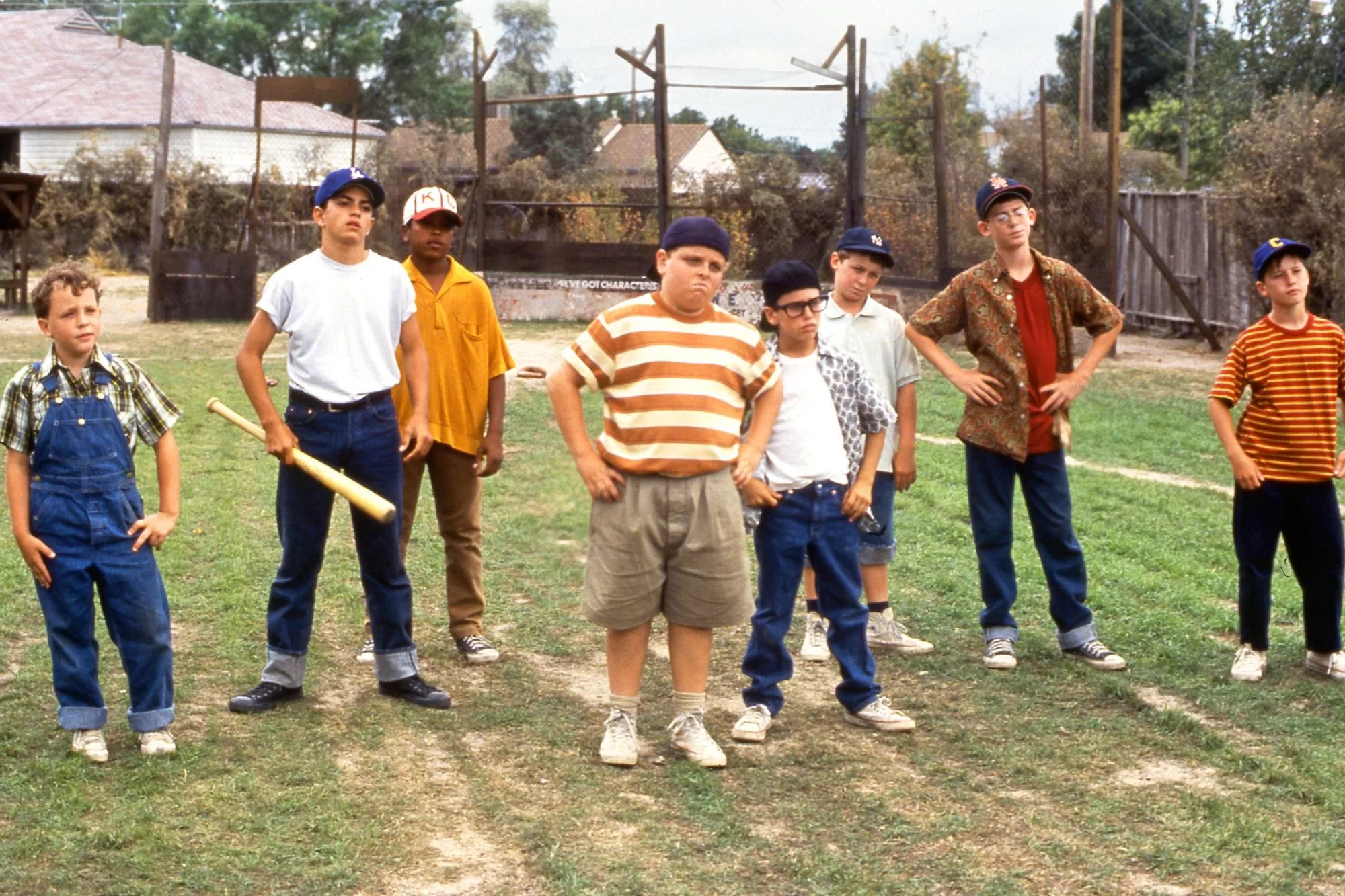When I was a child, there was a certain type of movie that held fascination above any other. There’s no specific genre for this kind of film, though they certainly fit under the umbrella of children’s adventure stories. A brief description of some of the wavetop examples of this yet-to-be-named category should help illustrate the sentiment they exude.
I was seven years old when The Sandlot (1993) debuted, and I watched children not that much older than I was traverse their entire town as if it were their own backyard. Kids departed homes of varying distances from their baseball diamond focal point by themselves and were left to their own devices for the entirety of the day. The film also shows them walking through some genial, little Main Street USA to purchase new baseballs, marching to their town’s swimming pool without parents, and running about explosive-laden July 4th block parties, completely unattended.
These surroundings and ways of life were alien to my typical upbringing. It’s true that not all American kids of my generation were reared in the suburbs, but a vast majority were, and it certainly wasn’t similar to what The Sandlot depicted. My area’s public swimming pool was on the other side of a five-lane commercial road and a county highway, precluding the ability to walk or ride a bike there in a timely or safe manner. We had no Main Street; instead, there were the above-mentioned commercial byways that were lined with used car dealerships, fast-food chains, minority-owned gas stations that sold weed paraphernalia under the guise of tobacco products, mega-sized supermarkets, and wide-set decaying strip malls that housed endless nail salons, hairdressers, or thrift stores. Though there were other children in my haphazardly laid-out housing tract, there were few places to claim as our own; the nearest public space (an elementary school playground) was walled off with chain-link fence and locked outside of school hours; it was also guarded by rent-a-cops because of increased vandalism by more recently settled suburbanites from the city.
By this point, many readers are surely comparing the era depicted in The Sandlot, the 1960s, to my own childhood years described, the 1990s and beyond, and attributing a myriad of reasons for the difference in lifestyle. Most of these rationales are probably accurate, and they’ll be examined later; however, this change did not prevent Hollywood from continuing to show portraits of free-roaming children in my own time.
Two tales from yesteryear were updated to modern times, portraying the same children-running-amok-in-a-safe-town vibe. The first was Dennis the Menace (1993). A screen adaptation of the long-running newspaper cartoon and 1950s TV series, it was released the same year as The Sandlot. Dennis showed a child even younger than I was at the time innocently antagonizing his elderly next-door neighbor, trekking the nearby woods with friends, and wandering his town’s streets on his own, always with a red-rider wagon in tow. Trouble in paradise is introduced when a drifter comes to town and abducts Dennis; the entire community is mobilized to save him but it’s unnecessary because his child resourcefulness thwarts the machinations of the evil intruder. The other film was The Little Rascals (1994), updating a series of short flicks from the pre-war years. Rascals’ opening scene depicts their clubhouse in an abandoned lot, set on a hill just above an American city (Los Angeles), as if the boys could descend into that metropolis in a completely safe and normal manner; anyone that knows anything about Downtown LA wouldn’t let their child rove around with less than an armed escort. The film is also replete with endless scenes of children rambling through their municipality as if it’s all just one giant playground.

Dennis can safely ride his bike, even at night
There were other films of this genre that catered specifically to girls. Like The Sandlot, The Secret Garden (1993) was another harken-back-to-simpler-times, this time across the pond and at the beginning of the last century, showing a young girl in full adventure mode. There was also Harriet the Spy (1996), which actually had the balls to depict a young White girl traversing 1990s New York City all by herself.
For the films that took place in my own time, they showed something I didn’t have and never would as completely normal. Even at such a young age, I couldn’t help but wonder, were there places actually like this?
A few years later, when I was 12 years old, my family took a trip to the other side of the country to visit a relative stationed in Southern California. The vacation included a day excursion to Balboa Island, a tiny residential community nestled in Newport Harbor. There I saw blonde and tanned kids, my own age and unsupervised, zipping around on skateboards and holding surfboards, making their way to the beach. I couldn’t believe my own eyes. This was also during the third surge of popularity in California surf and skate culture, culminating in TV shows and films such as Orange County (2002), The O.C. (2003–2007), and for children, Rocket Power (1999–2004); this gave me the false impression this may have just been a West Coast thing. Unbeknownst to my young mind, places like Newport Beach were not for me and my family. In Dolores Hayden’s A Field Guide to Sprawl, these types of communities are known as Valhallas: “An attractive town adopted as a favorite spot by the super-rich.”
It certainly wasn’t all situated along the pristine California coastline, but today’s Americans might be shocked at how common this innocent, carefree, and essentially wild upbringing once was. Just ask your parents or grandparents about their background compared to your own and I’m sure you’ll notice the difference.
Now, an enormous effort has been underway to make us think that the past was all a ruse, that some phantasmagoric screen has been laid over our eyes to trick us into thinking that 1950s America was really just some propagandized illusion. As someone enamored with the past and prone to talking about it, I can count more than zero occasions where some (usually female) counterpointer has made the argument that the past was only OK if you were a White male. Unbeknownst to the upholders of this modern perspective on our own recent history, this is the end result of a massive revisionist history campaign/force-fed deconstructivist mindset, aimed directly at what can now be considered antiquity. Your modern feminist is legitimately under the impression that every single 1950s housewife was immediately backhanded across the face for no reason on a daily basis the minute her husband returned from work and not one woman was happily raising children in a nuclear family. Untold Americans really think that Western civilization’s sole purpose is to keep down the Black man, all-the-while 50 Marshall Plan’s worth of money has been given to Africa and trillions of dollars of welfare and public housing have been disproportionately provided to Black people.
It’s no surprise that Hollywood has changed their tone on this former way of life; rather than glorify the typical nuclear family and safe town or neighborhood, they took to poking holes in it. Though there are several examples, Pleasantville (1998) may be the best semi-recent prototype. In his less-than-utopian 90s high school setting, teenager David, played by Tobey Maguire, obsessively watches an affable 1950s sitcom, yearning for simpler times. Through a bizarre circumstance, he and his slutty sister Jennifer, played by Reese Witherspoon, are sucked back in time and find themselves in the show’s setting. Lo and behold, they discover that the town is stodgy, repressive, and bad! Fast forward to our current year, where any depiction of the pre-modern era is auto-associated with racism, sexism, or any other type of -ism imaginable.
So, what happened to small-town America and its associated way of life? How did the tight-knit town or urban neighborhood get replaced with the isolating suburb? When did family-owned, main street businesses get subsumed by commercial byway corporate chains? Why is it suddenly so impractical and unsafe for children to roam in their own communities? How did Hollywood so seamlessly go from adoring small-town America to essentially mocking it?
There is almost limitless literature that expresses the woes of suburbanism and sprawl, often focusing on its environmental impact, lack of culture, and isolation (as I have), but does anyone point a finger in a direction other than toward vague, capitalist fat-cats, profiting of building contracts and the like? E. Michael Jones’ The Slaughter of Cities: Urban Renewal as Ethnic Cleansing certainly does. The book’s summary states, “What began as the World War II intelligence community’s attempt to solve America’s ‘nationalities problem’ and provide workers for the nation’s war industries degenerated by the early post-war period and full-blown ethnic cleansing.” And for those still too stuck in the mainstream, Jones’ use of the word “ethnic” is not what you’re probably thinking.
To no surprise, as bored suburban kids became young adults, the first thing many of them wanted to do was leave. What began as a trickle at the end of the last century turned into a deluge in the new millennium: the gentrification of urban centers, many on the ruins of former industrial zones. Critique of gentrification also abounds, and its accusations are as eye-rolling as conventional annoyance with sprawl: the near-constant reference of gentrifiers out-pricing and displacing “local” inhabitants — often recent migrants, minorities, Black/Indigenous People-of-Color, or any other protected class; as if these people built the Western cities in which they reside. In the documentary Flag Wars (2003), the African-American population of Columbus, Ohio fighting gentrification — which, in the film, was almost exclusively being executed by gay men — actually had the audacity to refer to themselves as “natives”; the documentarians give little tribute to who occupied the neighborhood in question prior to Blacks.
Unfortunately, all good things must come to an end, urban gentrification included. In the brief span of roughly 20 years (2000–2020), previously destitute neighborhoods had billions of dollars invested in them, untold amounts of development and revitalization, and huge influxes of neo-yuppies, only for it all to come to a screeching halt. Places like Downtown LA or San Diego are perfect examples: luxury condo high-rises complete with rooftop swimming pools and chic French and Italian restaurants, only to find literal human shit, the odor or urine-stained pavement, and often violent vagabonds (that don’t share the same complexion as the one in Dennis the Menace) at street level. The Summer of Floyd and its associated promotion of lawlessness has seemingly again reversed the flow of safety in urban areas. Sanctuary cities have given get-out-of-jail-free cards to the most deranged and unhinged “citizens,” making almost every American metropolis again an urban hellscape.

Black Lives Matter mayhem
What this has caused is a sort of second-order gentrification. Those young, mostly millennial, urban pioneers are now gentrifying new areas: towns. Yes, the very same towns these adults viewed as children in The Sandlot, Dennis the Menace, The Little Rascals, and so on. Once working-class dwellings within walking distance of all but abandoned main streets now go for a premium on the real estate market. Long-shuttered storefronts now house $30 smoothie shops and stores that sell sweaters for dogs. This isn’t necessarily new; as referenced above, our nation’s Bond villains have been staking out little Valhallas for themselves for quite some time now. The documentary series Visions of Heaven and Hell (1994) states, “The wealthy and the fortunate have always lived above the rest,” and cites Telluride, Colorado as a textbook example of a once-common town setting now sequestered for only the super-wealthy. In the post-Floyd world, the Diversity-is-our-Strength crowd is fleeing the multiculturalism they all claim to love en masse, forming little Tellurides wherever they find blueprints to do so; just ask anyone in Boise, Idaho or Hudson, New York. It’s an almost hysterical fulfillment of Joseph Sobran’s quip from when a bachelor’s degree still meant something, “The purpose of a college education is to give you the correct view of minorities, and the means to live as far away from them as possible.” Will Hollywood again portray this style of living in a positive light, where kids can roam about, free from worry and safe from danger? For anyone reading the tea leaves, not likely.









